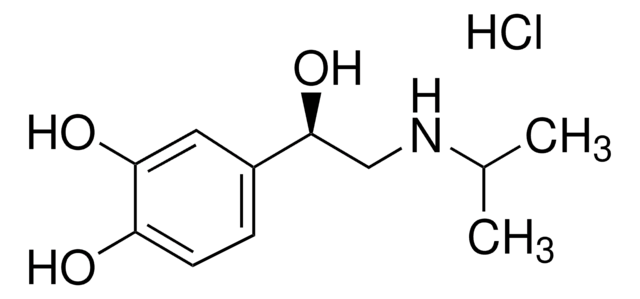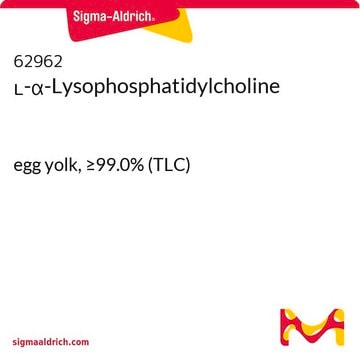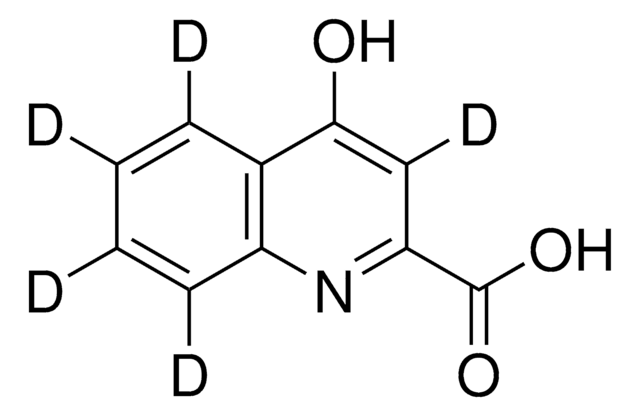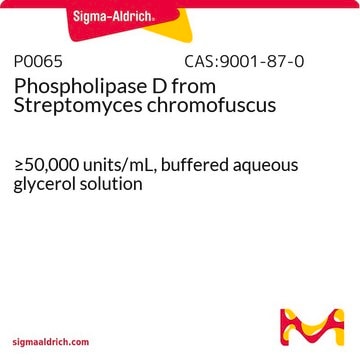Alle Fotos(1)
Wichtige Dokumente
L1381
L-α-Lysophosphatidylcholine from bovine brain
≥99%, Type V
Synonym(e):
1-Acyl-sn-glycero-3-phosphocholine, L-α-Lysolecithin
Anmeldenzur Ansicht organisationsspezifischer und vertraglich vereinbarter Preise
Alle Fotos(1)
About This Item
Empfohlene Produkte
Beschreibung
zwitterionic
Typ
Type V
Assay
≥99%
Lipid-Typ
phospholipids
Lagertemp.
−20°C
Allgemeine Beschreibung
L-α-Lysophosphatidylcholine is a major plasma lipid, derived from phosphatidylcholines that includes glycerol and sphingoid based lipids with one fatty acid. It is an important cell signaling molecule for G-protein coupled receptors.
Anwendung
L-α-Lysophosphatidylcholine from bovine brain has been used:
- to determine the dose-dependent high-mobility group box 1 (HMGB1) release in macrophage and monocyte cultures by production of lysophosphatidylcholine (LPC)
- for lysolecithin demyelination of mice brain tissue
- for demyelination of axons
Biochem./physiol. Wirkung
L-α-Lysophosphatidylcholine possess cytotoxic effects and is present at high level in ischemia and atherosclerotic aortas.
Lysophosphatidylcholine is a major component of oxidized low density lipoproteins, and has been implicated in various inflammatory reactions, including atherosclerosis.
Lysophosphatidylcholine is a major component of oxidized low density lipoproteins, and has been implicated in various inflammatory reactions, including atherosclerosis. It is a degradation product of phosphatidylcholine by phospholipase A and has cytolytic properties. The product is used to demyelinate spinal neurons and study the processes underlying remyelination. It activates protein kinase C, p38 MAP kinase, p42 MAP Kinase, and the jun kinase (JNK) pathway, and stimulates transcription of c-jun. Lysophosphatidylcholine accumulates during cardiac ischemia and may induce arrhythmias by uncoupling gap junction communication, and increase ischemic damage by enhancing Na+ loading in cardiac myocytes. It also activates TREK1, TREK2 and TRAAK K+ channels.
Leistungsmerkmale und Vorteile
This compound is featured on the Phospholipase D page of the Handbook of Receptor Classification and Signal Transduction. To browse other handbook pages, click here.
Sonstige Hinweise
Contains primarily palmitic, stearic and oleic acids.
Lagerklassenschlüssel
11 - Combustible Solids
WGK
WGK 3
Flammpunkt (°F)
Not applicable
Flammpunkt (°C)
Not applicable
Persönliche Schutzausrüstung
Eyeshields, Gloves, type N95 (US)
Hier finden Sie alle aktuellen Versionen:
Besitzen Sie dieses Produkt bereits?
In der Dokumentenbibliothek finden Sie die Dokumentation zu den Produkten, die Sie kürzlich erworben haben.
Kunden haben sich ebenfalls angesehen
Myelin regulatory factor drives remyelination in multiple sclerosis
Duncan GJ, et al.
Acta neuropathologica, 134(3), 403-422 (2017)
Suppression of HMGB1 release by stearoyl lysophosphatidylcholine:an additional mechanism for its therapeutic effects in experimental sepsis
Chen G, et al.
Journal of Lipid Research, 46(4), 623-627 (2005)
Metabolism and atherogenic disease association of lysophosphatidylcholine
Schmitz G and Ruebsaamen K
Atherosclerosis, 208(1), 10-18 (2010)
Human induced pluripotent stem cells differentiation into oligodendrocyte progenitors and transplantation in a rat model of optic chiasm demyelination
Pouya A, et al.
PLoS ONE, 6(11), e27925-e27925 (2011)
Yuan Wang et al.
Oncotarget, 7(32), 50937-50951 (2016-07-30)
The earlier study showed that lysophosphatidylcholine (lysoPC) induced apoptosis in human coronary artery smooth muscle cells (SMCs); however, the related molecular mechanisms are not fully understood. The present study investigated how lysoPC induces apoptosis in cultured human coronary artery SMCs
Unser Team von Wissenschaftlern verfügt über Erfahrung in allen Forschungsbereichen einschließlich Life Science, Materialwissenschaften, chemischer Synthese, Chromatographie, Analytik und vielen mehr..
Setzen Sie sich mit dem technischen Dienst in Verbindung.















